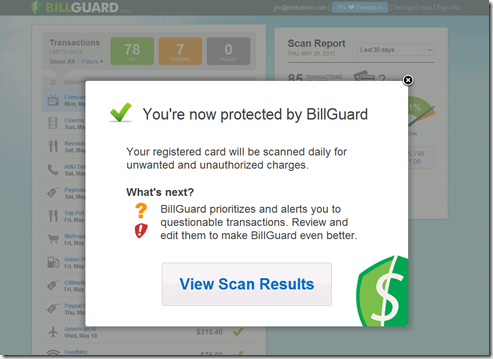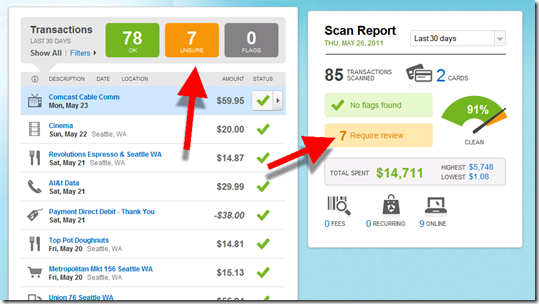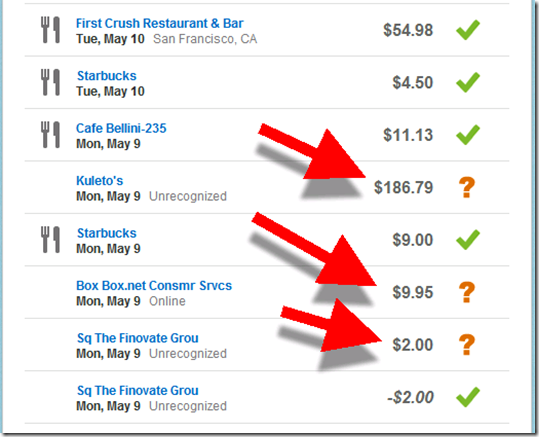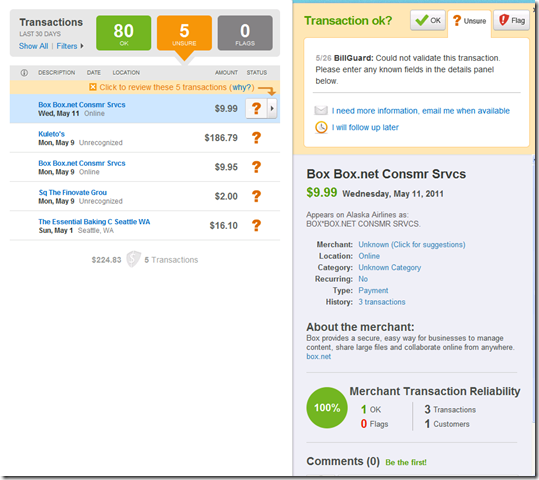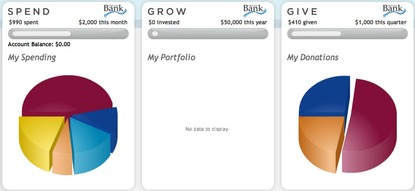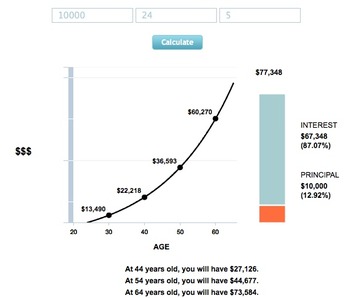- eWise Pay By Account
- eWise Pay Anyone
- eWise Account Aggregation
- eWise Personal Financial Manager
- eWise eAuthentication
M&T Bank Adds FICO Credit Score View to Online Banking, Charges $2.99/mo
 It figures. As soon as I write a report complaining about the dearth of online fee-based services, a major bank launches one, practically the same day.
It figures. As soon as I write a report complaining about the dearth of online fee-based services, a major bank launches one, practically the same day.
Buffalo, NY-based M&T Bank just released an upgrade to its online banking system adding:
- Intuit’s FinanceWorks PFM
- Equifax-provided FICO score
Both are good moves, but it’s the credit score service that’s especially novel. It’s integrated directly into online banking, so customers needn’t log in to another site to view their score. And the bank is charging for it, to the tune of $2.99 per month.
___________________________________________________________________________________
Potential
__________________________________________________________________________________
It will be interesting to see how M&T promotes the new feature to its online banking base which numbers 700,000 to 800,000 (active monthly users) based on traffic estimates from Compete. I’m also curious to see whether the bank upsells pricier, full-featured credit monitoring and/or credit reports to the $2.99/mo base. (I’d be surprised if they don’t.)
There’s no mention of a free-trial period, but based on industry experience, that is likely to be one of the best marketing strategies available. Given all the misleading advertising in the market (“free” credit scores that cost $15/mo), I’m pleased to see that M&T is upfront about the cost, mentioning it within the first 50 words of the landing page.
With an aggressive promotional campaign, it seems possible the bank could eventually get 10% to 15% of its online base using it. Then M&T gets a dual benefit: a unique and powerful tool for its customers and $3.5 million in incremental gross revenues (if it hits 100,000 users). The bank can also upsell credit monitoring, credit scores for other family members, along with balance transfers and other credit products.
———————————
M&T Bank landing page for new integrated credit score (link; 6 Jun 2011)
Note: Pricing disclosed upfront (yellow highlighting is ours)
Note:
1. See our current Online Banking Report, Creating Fee-Based Online & Mobile Banking Services.
Alumni News — Week of May 30, 2011
![]()
- doxo explained how to use its online filing cabinet and “due date” alerts to help organize GroupOn, Living Social, and other daily deals. Link
- TheFinancialBrand.com discussed Oregon Federal Credit Union’s use of doxo and discussed other usage ideas such as uploading a scan of your passport prior to travelling. Link


![]()


Link

What is the ROI of banking innovation?
 An executive on the front lines of product development at a major financial institution recently asked me this question:
An executive on the front lines of product development at a major financial institution recently asked me this question:
How can I prove that innovation really matters to the bottom line?
I’ve been a “product guy” my whole career so I take it for granted that “building a better mousetrap” eventually trickles down to a boost to the bottom line. That worked at Microsoft, Apple and Caterpillar (my first job).
But they are manufacturing companies. That better mousetrap, be it Win95, the iPod, or a D10 tractor, brought in direct, usually profitable, revenues.
It’s harder if you are a retailer. If the Gap spends a million dollars to improve search and discovery on its website, will it really sell enough extra jeans and sweaters to make the investment back, let alone earn an acceptable return?
Banks are both retailers (branch and online) and manufacturers (checking accounts, loans). But today, the P&L from their digital efforts is more like the Gap than Apple. You have to sell a lot of extra checking accounts and car loans to justify even a modest website investment. This has held back digital investments for 15 years (see note 1).
But what if banks started acting more like a manufacturer when it comes to digital products, by creating new services to package and sell on their own merits.
For example, instead of spending a couple hundred thousand every year to give everyone remote check-deposit capabilities free of charge, create a new digital product called, The Magic Check Deposit Service, and sell it for $2.99/mo. This product not only reduces costs, since it will have far fewer lapsed and/or clueless users, but also pegs a monetary figure to the service, thereby increasing its perceived value even if you end up giving it away to your best customers.
______________________________________________________________________________
The Numbers
_____________________________________________________________________________
Let’s crunch a few numbers. Assume it costs $0.50/mo to support each user + $0.25 per check deposited + $20 per tech support call (I made these up so don’t quote me).
Free service:
Cost = 50,000 users x 0.67 checks/mo + 1,000 support calls per year = $420,000
Fee revenue = $0
Customer retention value = ??? (some positive number)
———————
Net = ($420,000)
Subscription service:
Cost = 5,000 x 4 checks/mo x 100 support calls per year = $92,000
Revenue = 5,000 x $2.95/mo = $177,000
Retention value = ??? (same as above)
——————–
Net = +$85,000
Change in net (delta) = $500,000
______________________________________________________________________________
Bottom line
__________________________________________________________________
With either approach you get to tout the benefits of the new innovation to capture the branding value. But under the subscription model, only those who really stand to benefit from the service use it, and you end up with a small profit or at least less of a loss. In the above example there is $500,000 gain compared to the free model.
Yes, this is over simplistic. Yes, you’ll take some grief for charging when others are giving it away. It’s possible you might even lose a few customers, but not $500,000 worth. And the biggest benefit of all, you can actually afford to create the new service now, instead of tabling it for five years until it becomes a competitive necessity.
Back to the original question. Honestly, I have no idea how to prove that innovation has a good ROI. What I do know is that for the past 100+ years, clever manufacturers have created billions in value by beating the competition with new products and services. I’m pretty sure financial companies will do the same with their online and mobile offerings.
———————————————–
Note:
1. See our current Online Banking Report, Creating Fee-Based Online & Mobile Banking Services.
Cash is Still King at PayNearMe

- You do not have a credit or debit card (24% of U.S. households)
- You prefer to pay with cash (most teens and 54% of adults)
- You do not want to divulge personal information online
- You would like to repay a loan with cash
- Gift card amount
- Email address
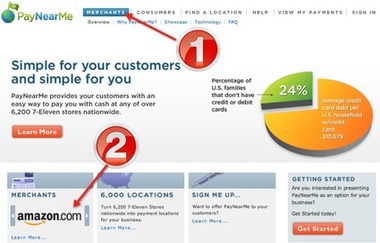
- Zip code
- Password
![]()

Alumni News — Week of May 23, 2011
![]()
Aptys Solutions
Aptys Solutions signed with Banker’s Bank, a top check depositor with the Federal Reserve Link
Backbase
Backbase to host webinar on how to use social media in financial services Link
Betterment
![]()
- Betterment announced a growth of over $10M under management and over 4000 customers in first year Link
- Betterment celebrated its first birthday Link
Bill.com
Bill.com is working to improve its mobile offering for small and midsized businesses Link
Boku
Mobile Entertainment explained how Boku will revolutionize pay-by-mobile for digital goods Link
Capital Access Network
CNBC explained how Capital Access Network solves the need to use financial creativity Link
Credit Karma
WiseBread Blog interviewed Credit Karma CEO Link
doxo

- doxo’s first fan video was posted online Link
- Oregon employees were the first to give its members doxo’s online file cabinet Link
- TechFlash highlighted the benefits of using doxo to achieve paperless business Link
- 2Minute Finance interviewed doxo at FinovateSpring Link
Dwolla
- Dwolla was listed by inc Tech as one of three startups you must know from Big Omaha Link
- Credit Union Times listed Dwolla as a new P2P service rivaling ‘bank giants’ Link
edo Interactive
MyBankTracker interviewed edo Interactive COO about its Prewards service Link
Expensify
Slate explained how Expensify will help the ‘frequent flier’ Link

Kabbage
Technorati described how Kabbage works with eBay Link
Lending Club
- Mint.com’s blog covered what you need to know about Lending Club Link
- San Francisco Business Times commented on Lending Club’s strong backing from both investors and lenders Link
- San Francisco Times reported that Lending Club stated it is not planning to go public for several years Link
LendingKarma
Entrepreneur featured LendingKarma as a good tool to use when borrowing money from family or friends Link
Lendio
San Francisco Chronicle reported that Lendio offers funding opportunities for new grads Link
Lodo Software
Lodo Software was described as a startup providing jobs in the “Silicon Prairie” region, a.k.a. Omaha Link

Monitise
Monitise released a report predicting that the majority of consumers will use mobile money services within the next three years Link
Mortgagebot
Mortgagebot reached 1000 clients, one of its goals from the beginning Link
PayDivvy
2MinuteFinanced interviewed PayDivvy about its services Link
![]()
PayNearMe
BillShrink examined PayNearMe’s cash payment service Link
peerTransfer
Mass High Tech interviewed Iker Marcaide from peerTransfer about becoming an entrepreneur Link

ProfitStars
ProfitStars announced a new version of Margin Maximizer that’s now available as a hosted solution Link
Robot Dough
2MiniuteFinance toured RobotDough’s demo during interview at Finovate Spring Link
SecondMarket
- Wall Street Journal stated that SecondMarket helped fuel the tech boom Link
- CNBC interviewed SecondMarket for an explanation of the change in trading numbers Link and Link

Smarty Pig
Smarty Pig launched new sharing features, including activity sharing and goal sharing Link
Striata
Striata will host a June 2 webinar for implementing successful ebilling strategies Link
ThreatMetrix
San Francisco Chronicle covered ThreatMetrix’s research around mobile transaction activity Link
TILE Financial
TILE Financial released a Financial Identity Profile to strengthen the connection between advisors and under-30 consumers Link
![]()
TradeKing
TradeKing divulged the lineup of its free webinars in June Link
Tyfone
Tyfone won 2010 Asia Pacific Smart Card Association Award for its NFC innovation and implementation Link
Wikinvest
Dow Jones Advisor highlighted Wikinvest as a way to analyze portfolios Link
Wonga
- Wonga won 2011 Red Herring Top 100 Europe Award for exceptional accomplishments Link
- Wonga won the Media Momentum Awards, a coveted award for digital media companies in Europe Link
- Wonga’s Errol Damelin discussed consumer-centric credit Link
Xero

- Diversity Limited commented on Xero’s move to the US markets Link
- Xero and Keebo teamed up to help you manage and process receipts Link
- New Zealand Herald commented on Xero’s surging revenue Link
Zecco
- The Wall Street Journal reviewed Zecco’s new Facebook app Link
- Zecco launched an app for stock trades & viewing realtime market data on Facebook Link
Zopa
Zopa shows how it helps consumers protect against inflation Link
Launching: BillGuard’s “Anti-virus for Credit Cards”
 Fintech made a good showing at TechCrunch’s semi-annual Disrupt conference in NYC. Of 32 startups that launched on stage, three were financial-related:
Fintech made a good showing at TechCrunch’s semi-annual Disrupt conference in NYC. Of 32 startups that launched on stage, three were financial-related:
- Spenz: A mobile PFM (Disrupt demo)
- InvoiceASAP: A mobile invoicing app with accounting integration (Disrupt demo)
- BillGuard: A transaction-monitoring service (Disrupt demo)
And both InvoiceASAP and BillGuard (discussed below) were selected to come back on the third day and compete, along with four other startups, for the top prize in front of an all-star panel of judges. The judges selected BillGuard runner-up behind GetAround, a clever peer-to-peer car rental service which wowed the crowd, also taking home the People’s Choice award. _____________________________________________________________________________
BillGuard overview
_____________________________________________________________________________
The TechCrunch judges and analysts went gaga over BillGuard. Everyone wanted to use the service, and most wanted to invest in the company.
However, the company recently landed a $3 million Series A round (February 2011), so they’ll have to wait. Investors include: Bessemer Venture Partners, Chris Dixon, Ron Conway, IA Ventures, Howard Lindzon and Yaron Galai. The Israeli company has 12 employees. The founders are Yaron Samid, CEO, and Raphael Ouzan, CTO.
Currently, BillGuard is free for the first card and can be upgraded to monitor an unlimited number of cards for $4/mo, a classic freemium model.
In the two days following the company’s Monday launch, users added 10,000 cards to the alerting service. In the initial scans, looking back through 30 days of transactions, the company identified potential nuisance charges on 20% of the cards analyzed. The flagged transactions ranged in value from $2 to $6,000 with the latter described as “fraud on a very wealthy person’s card.” ______________________________________________________________________________
How it works
_____________________________________________________________________________
1. Register at the site with just your email address and ZIP code
2. Enter your username and password for a credit card account into the Yodlee-powered aggregation engine
3. The past 30 days of transactions are immediately downloaded and analyzed for potentially fraudulent or unwanted charges (see screenshot 2)
4. Charges are color-coded by risk assessment (green = good, orange = review, red = flagged) (see screenshot 3). Much like anti-virus companies, BillGuard relies on its user base (crowdsourcing) to identify nuisance and fraudulent charges.
5. You can quickly call up the “reviewable” transactions and choose to mark them “good” or wait for more information on the merchant from BillGuard and its user base (screenshot _______________________________________________________________________________
Analysis
_______________________________________________________________________________
In my case, the service did not find any bad transactions in the 85 it reviewed from my primary business and personal credit cards. All seven marked “unsure” were fine. None were flagged red.
But according to the company, the average American loses $300 per year in unwanted charges, and I’m way over that. Just last year, I lost more than $1,000 because I had the wrong plan on my mobile phone. But that was a legitimate charge from an existing merchant of mine. BillGuard doesn’t guard against stupidity, yet, but it wouldn’t take a whole lot more intelligence to start flagging this type of out-of-bounds charge as well.
The potential for financial safeguard services is huge. Just look at the multi-billion credit-monitoring industry, or Mint.com for that matter which alerts users to bank fees and keeps a running total. The question isn’t whether consumers want this type of protection, certainly they do. The issue is whether anyone will take the time to set up the service, pay for it, and then take the time to monitor their accounts.
BillGuard knows that and is actively pursuing deals with large banks to package the service into online banking. In its Monday demo, the company said it was in talks with three top-ten banks (on Wednesday they said, “Make that 4”).
Distributing BillGuard would be a mixed blessing for banks. Earlier detection of fraud would be useful, but the labor involved in working through increased dispute resolution, especially false positives, would have to be factored in. But again, BillGuard understands the dilemma and is developing dispute-resolution capabilities that will SAVE issuers time and money.
I predict we’ll be seeing a lot more from this company so keep them on your radar. I know we will.
—————————————-
1. Welcome screen after first download & scan (26 May 2011)
2. Initial scan results with 7 transactions marked “review”
3. Transactions are color-coded by risk assessment
4. The transaction review page
5. TechCrunch finalist demo (click to watch on TechCrunch site; )
—————————
Note: For more on online personal financial management (OFM/PFM), see our Online Banking Report.
Spend Grow Give: TILE Financial’s New Learning Environment

- Account Overview
After logging in, I see an overview of my account divided into three categories:
Each contains a pie chart of my spending, investments and charitable contributions. Please note that the Grow category is empty because I am using a test account without investments.
- Reference Bar
Pictured below, this feature has eight tabs and is located at the bottom of the user interface (see homepage screenshot at end of post). My favorite tab is TILEcasts, a unique reference tool that contains video clips of experts talking about subjects such as, “Here’s Why You Need Insurance.” The clips break down complex financial issues into bite-sized pieces with digestible language.
- Alerts
The interface includes customized alerts such as portfolio changes, budget limit approaches, and so on. Alerts are delivered via the TILE site, email, or text message.
- My Profile
At first glance, the profile appears similar to Facebook. I can upload my picture, update my status, and share with the TILE community, my financial advisor, my funder (i.e., parent/grandparent), Twitter, or Facebook.

- Features
The main part of the profile page is My Financial Identity, which features the homepage categories: Spending, Growing, and Giving, as detailed below. Each contains quizzes and tutorials that allow the user to understand what money means to them. TILE refers to this as a person’s “financial identity.”
– SpendingHere, I can see how well I know my budget. I take a quiz to test my knowledge of how much I spend on certain categories and am guided through a tutorial to help adjust
monthly spending habits. Another lesson teaches the basics of establishing credit.
– GrowingIn this section I can learn when to start investing, how to time financial
markets, and take a risk profile assessment. There is an easy-to-use calculator that inputs age, investment
amount, and interest (see graph on the right) to show growth over time.– GivingThis area features a quiz to help me discover causes I really care about and would allocate charitable giving to. It requires much thought and in the end helped me create my own mission statement.
New Online Banking Report Published: Creating Fee-Based Online & Mobile Banking Services
 The scariest thing about being a banking industry analyst, besides boring your family & friends, is looking back at the advice you handed out 5, 10 or even 15 years ago. While I’ve had my share of hits and misses, one thing I’ve been particularly adamant about, is the need to create fee-based online financial services. Sadly, this is one that’s been completely ignored so far (see note 1).
The scariest thing about being a banking industry analyst, besides boring your family & friends, is looking back at the advice you handed out 5, 10 or even 15 years ago. While I’ve had my share of hits and misses, one thing I’ve been particularly adamant about, is the need to create fee-based online financial services. Sadly, this is one that’s been completely ignored so far (see note 1).
If U.S. financial institutions had charged an average of $1 per month per user (note 2) over the past decade, it would have generated $10+ billion in incremental profits, much of which would have been reinvested into the channel.
Had that happened, we’d already have:
- Ironclad security
- Highly personalized 2-way alerts & messaging
- Integrated PFM and credit monitoring
- Responsive online/email customer service
- Killer mobile banking and iPad apps
- And much more
But what matters now is where do we go from here? Consumers have been trained to expect everything, even costly services such as online billpay, to be free of charge. Anyone who tries to charge fees for the existing state of the art risks massive backlash from customers and the media.
The way to introduce fees after the fact is to charge only for new value-added services such as those listed above. That way, no one pays fees unless they want the new benefit. It’s the classic freemium model, and it works well across a number of industries, just ask LinkedIn.
Our latest report lays out 33 value-added modules that could support a la carte subscription fees. We look at eight use cases where these modules are bundled together for various-high value segments:
- Power mobile users
- Road warriors
- Families/parents
- Small/micro business
- Homeowners
- Financial trackers
- Empty nest/retirees
- VIPs
Currently, the best examples of multi-tiered pricing in the United States is business online banking where a number of banks and credit unions have a basic free option and at least one higher-end “cash management” solution (see Western Bank screenshot below).
______________________________________________________________
About the report
______________________________________________________________
Creating Fee-Based Online & Mobile Banking Services (link)
Pricing 2.0: How new revenue models will propel online/mobile banking to the next level
Published: May 18, 2011
Author: Jim Bruene, Editor & Founder, Online Banking Report
Length: 44 pages (10,000 words), 17 Tables
Cost: No extra charge for OBR subscribers, $395 for everyone else (link)
———————————
Western Bank’s online banking pricing matrix (link, 15 May 2011)
————————–
Notes:
1. At least in North America. Financial companies in other areas of the world have been more successful with fee-based services.
2. This is an average amount. Most users would pay zero, but with 20% paying $5/mo, you get to the $1/mo average.
Alumni News — Week of May 16, 2011
![]()
Intuit

On Deck Capital

FinovateFall: Last Chance to Save $300 on Sep. 20-21 Event
![]() Thanks to everyone who made FinovateSpring a success just a week ago (my Twitter transcript here). But innovation doesn’t stand still, so we are already collecting applications and selling tickets for FinovateFall in New York City.
Thanks to everyone who made FinovateSpring a success just a week ago (my Twitter transcript here). But innovation doesn’t stand still, so we are already collecting applications and selling tickets for FinovateFall in New York City.
In fact, if you want to save on your fall ticket, register by the end of the day Friday (May 20) to receive $300 off regular ticket prices. Based on early results, it could be the biggest Finovate yet.
Last year, the conference expanded to two days (selling out 3 weeks in advance) and the audience loved it. Once again, each day will be packed with our unique blend of short, fast-paced onstage demos (no slides allowed) and intimate networking time with top executives from the demoing companies. With each company receiving just 7 minutes onstage, FinovateFall is the only place to see dozens of fintech innovations in such a short period of time.
So make sure you are part of the excitement at the fifth annual NYC Finovate on Sep. 20 & 21, and save $300, by registering today!
——————————————————–
Last year’s presenters (FinovateFall 2010)
FinovateFall: Last Chance to Save $300 on Sep. 20-21 Event
![]() Thanks to everyone who made FinovateSpring a success just a week ago (my Twitter transcript here). But innovation doesn’t stand still, so we are already collecting applications and selling tickets for FinovateFall in New York City.
Thanks to everyone who made FinovateSpring a success just a week ago (my Twitter transcript here). But innovation doesn’t stand still, so we are already collecting applications and selling tickets for FinovateFall in New York City.
In fact, if you want to save on your fall ticket, register by the end of the day Friday (May 20) to receive $300 off regular ticket prices. Based on early results, it could be the biggest Finovate yet.
Last year, the conference expanded to two days (selling out three weeks in advance) and the audience loved it. Once again, each day will be packed with our unique blend of short, fast-paced onstage demos (no slides allowed) and intimate networking time with top executives from the demoing companies. With each company receiving just seven minutes onstage, FinovateFall is the only place to see dozens of fintech innovations in such a short period of time.
So make sure you are part of the excitement at the fifth annual NYC Finovate on Sep. 20 & 21, and save $300, by registering today!
——————————————————–
Last year’s presenters (FinovateFall 2010)









